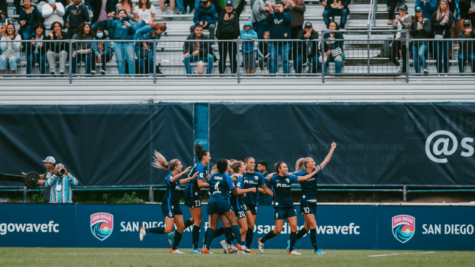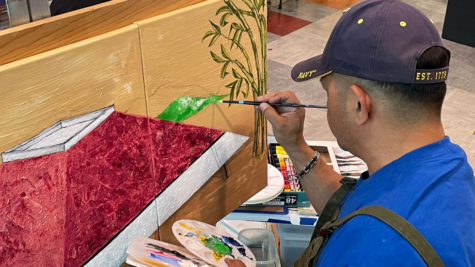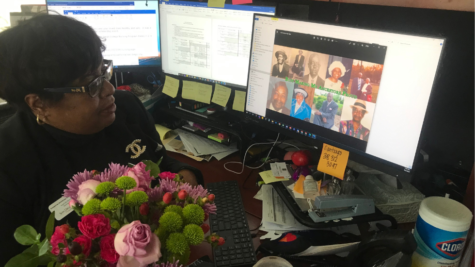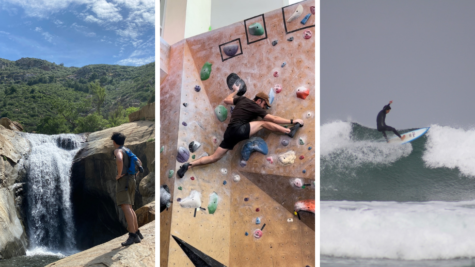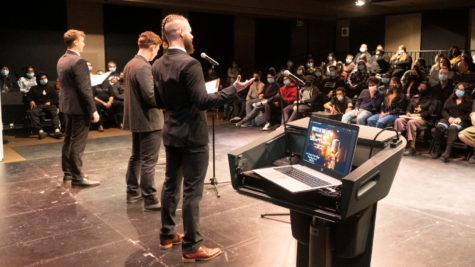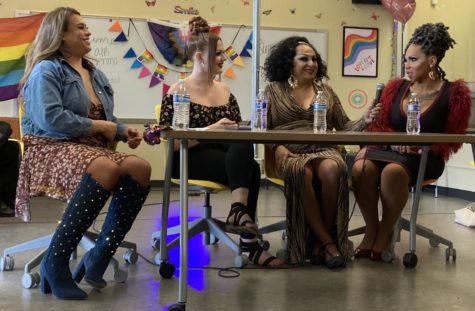Evolution of the ‘Con’: How the Center of Nerd Culture Became a Phenomenon of its Own
May 14, 2014
The lines are spiraling as the San Diego sun beats down on a couple thousand yards of tents that rest over a crowd that stretches behind the Convention Center toward the water.
Thousands of people are standing in line. Many of them have been waiting since last night, some of them for days, huddled under the tent poles and amongst the white chain-linked crowd control ropes like a little community. They’ve brought food. They’ve brought cards, rechargeable batteries to go with their laptops and portable video game consoles, anything to help pass the time. Many have dubbed them “Tent City.”
Excitement hums in the air. Gone are the piles of inventive makeshift beds that crowded the surrounding grass area and sidewalks overnight — ranging from pool floaties to inflatable mattresses, yoga mats, beach chairs and sleeping bags. Everyone is ready.
But something buzzes above the rising excitement, something even bigger. Commotion. It’s equal parts excitement and anxiety this morning. Not all of these people are going to make it into Hall H, the Convention Center’s largest and most prestigious room, and they know it, but they’re still here, still trying.
This phenomenon of fanatic proportions is not limited to a single celebrity, rock star or movie premiere. That would be too simple. It’s much bigger. It feels like what it would be like if you packed all of that fan pandemonium into one.
This is San Diego Comic-Con International.
And this was 2013, where the event actually assembled the entire X-Men during a panel promoting “X-Men: Days of Future Past,” where Oscar winner Jennifer Lawrence took the stage during a “Hunger Games: Catching Fire” panel, and where throngs of fans will sleep (or not, depending on how you look at it) in line for the chance to see and talk about their favorite stars from “Game of Thrones,” “The Walking Dead” and “Sherlock.” This is the year that will mark the 50th Anniversary of “Doctor Who” and a 20th anniversary celebration of cult classic “The X-Files” in Hall H’s just a tad bit smaller sister room, Ballroom 20, and where the previously-in-development-hell “Batman vs. Superman” movie will finally be announced. In the exhibit hall stands an enormous replica of “The Walking Dead” prison set and hundreds of tables of comics and studio booths for attendees to grab not just freebies, but a chance to rub elbows with the artists and creators they’ve admired and become such fans of.
Think of Comic-Con as the nerdy, pop culture university of your dreams. The beauty of the convention is that everyone can find a home, something that interests them, here.
The convention has stretched beyond the Convention Center, which itself has tried to change with the times, undergoing various construction and renovations in recent years to keep up with the event’s popularity. It’s quite literally taken over downtown. There are the big-budget blockbusters, the previews for yet-to-be-premiered television shows and movies with promotional art that stretches over the top of downtown’s buildings. There are programming events and movie screenings throughout the day and long into the night for attendees to enjoy at the hotels next door and outdoor parks. There are food trucks offering free pizza and tacos, free events at Petco Park, game zones, anime, prizes, free concerts in the Gaslamp Quarter, and even rooms where attendees are served free food and ice cold drinks with a flash of their badge.
You’re almost guaranteed to find something to be a fan of here.
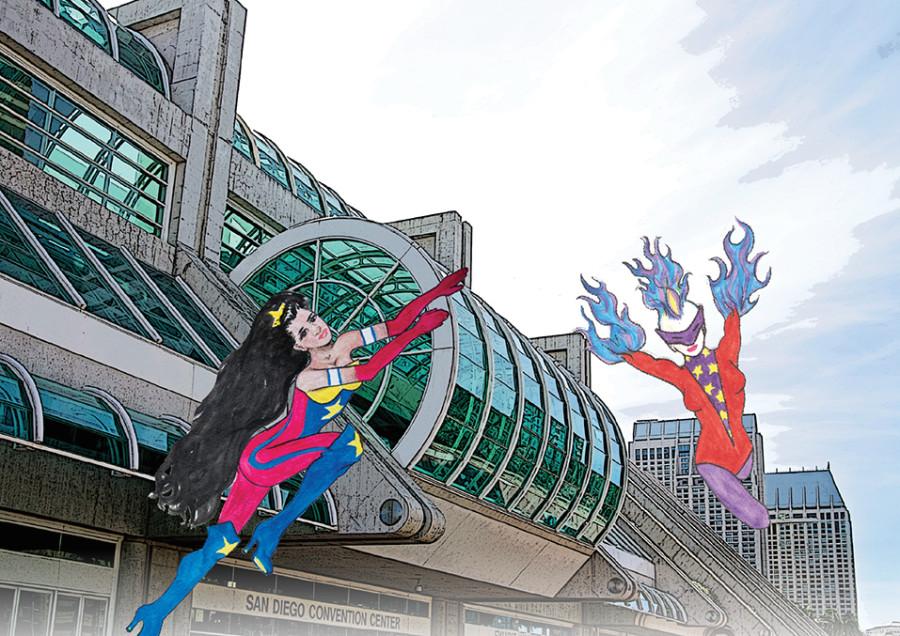
Beginnings and History
Comic-Con began as a one day “mini-con” and was organized by three budding entrepreneurs: comic book writer and letterer Shel Dorf, comic fan and collector Richard Alf and publisher Ken Kreuger. According to The Huffington Post, together, the trio wanted to give Southern California its very first comic book convention. The then 17-year-old Alf not only helped co-found, bankroll and organize the event, but even drove the three entrepreneurs around in his old Volkswagen Bug.
According to Screenrant.com, the first events under the convention’s banner were held in 1970 with a whopping (hold your breath) 145 and 300 attendees each in the basement of the U.S. Grant Hotel. Compare that to the the strikingly different 130,000 number of attendees that San Diego attracts annually who make the pilgrimage in the name of all things nerd.
Though its roots were founded at the U.S. Grant Hotel, the relatively modest event soon made its rounds, calling both the El Cortez Hotel and then the Convention and Performing Arts Center home, before settling down into a more permanent residence at the San Diego Convention Center, where it’s still currently held.
Naysayers and hipsters alike may be angry at the juggernaut that the convention has become, but according to Comic-Con’s official website, this was the founders’ vision from the start. The show was always supposed to showcase and include their love of comics, but was always planned to include other aspects of popular culture and the arts that “they enjoyed and felt deserved wider recognition,” such as films, science fiction and fantasy literature.
The convention underwent one more name change, transforming from the San Diego’s West Coast Comic Convention in 1972, to the San Diego Comic-Con the following year, during its fourth annual event. The nonprofit event took on its official current namesake and became San Diego Comic-Con International in 1995.
2000s and Change of Phenomenon
As far as popular culture goes, and that includes big film events and previews, the big movie markets didn’t give the convention the time of day until the mid 1970s. That is, until “Star Wars” changed it all, making an appearance at the convention through a slideshow presentation that was held in 1976, according to Screen Rant. But it would be another 30 years before the rest of the movie and television world got the the memo.
It wasn’t until around 2001 that many fans felt a shift. Hollywood finally began to recognize the power of the convention and of the people who went there. Previews for bigger movies, especially highly anticipated blockbusters such as “Spider-Man” and “Star Wars: Episode II,” were suddenly becoming prioritized and shown to excited attendees in advance of their release dates. In recent years, A-listers have made it to the convention in droves, with Angelina Jolie, Hugh Jackman, Sandra Bullock, Robert Downey Jr., Stan Lee, Matt Damon, Justin Timberlake, Jennifer Lawrence, Halle Berry, Charlize Theron and even Metallica all having made appearances in recent years.
The last decade has been an emotional rollercoaster for fans with “Iron-Man,” “The Amazing Spider-Man,” “Watchmen” and “Marvel’s The Avengers” all being previewed in the legendary Hall H. And the convention itself has quite literally doubled and tripled in size from its beginnings at the Convention Center. According to Comic-Con.org, when it opened its doors there in 1995, it attracted 22,000 visitors.
The 2000s truly marked a shift in the force, and Hollywood (and for that matter, the rest of the world) has finally taken notice of the power of Comic-Con, and by that definition, its attendees, the fans. It suddenly became cool to be nerdy. It suddenly became cool to be able to tell people you were going to Comic-Con.
In 2008, Comic-Con sold out for the first time in advance of the event.
Beyond San Diego?
Contractually, the Los Angeles Times reports, that the convention is slated to stay in San Diego through 2016, but rumors have swirled that the convention will pack up and make a home somewhere else, the most popular rumors being Irvine or elsewhere in Orange County, Los Angeles and even Las Vegas.
According to the Unofficial San Diego Comic-Con Blog, this year the convention sold out in 93 minutes, and whether it’s your first time at the convention or you’re returning, Comic-Con is that one experience you must have at least once. (Our pro tips? Pack some lunch, wear comfy shoes, make friends in line, and don’t think you’ll make it to everything you want to see — because you won’t.)
But if you know what it’s like to be a fan and are able to stand massive crowds, Comic-Con is for you. You’ll be amongst friends who know what it’s like to be you, and in a city like San Diego, what’s cooler than knowing that Comic-Con, the Comic-Con, is in our own backyard?


